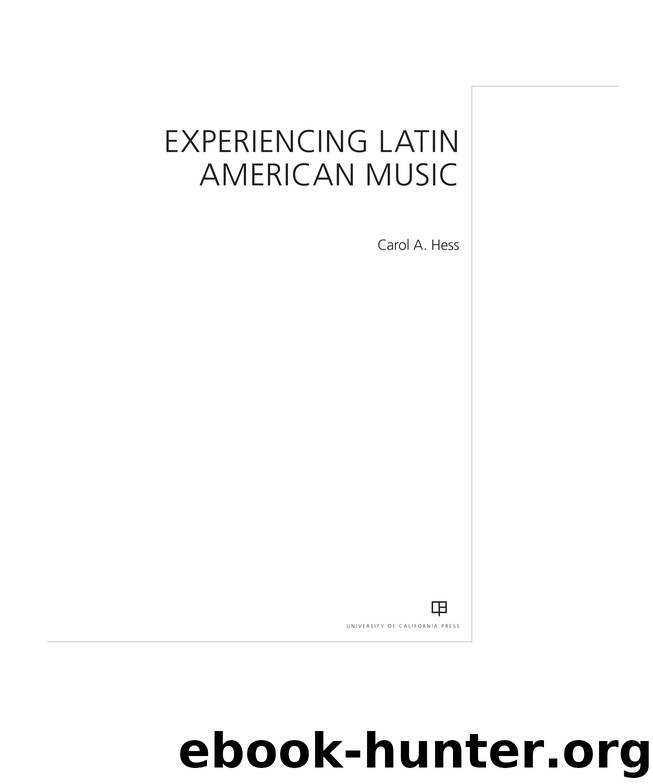Experiencing Latin American Music by Carol A. Hess

Author:Carol A. Hess
Language: eng
Format: epub
ISBN: 9780520285583
Publisher: University of California Press
The Deer Dance as Ritual
Some key participants in the Deer Dance are introduced on Palm Sunday, the first day of Holy Week. These include the pascolas, individuals who will dance and tell jokes throughout the week. The word probably derives from “Pascua” (Spanish for Easter) although the pascolas largely overlook any sacred messages, instead dedicating themselves to entertaining. The pascolas are accompanied by drummers and cantoras, women who sing in either Spanish, Latin, or Yoreme, an indigenous language. In enacting parts of the Holy Week story, group roles are also possible: one crowd of participants will agitate to have Jesus killed while another defends Jesus.
The dance portion of Holy Week reaches its climax the night before Easter Sunday, when the dancers perform at an all-night ceremony called a pahko. Its central feature is the Deer Dance, which is accompanied by a deer song called maso bwikam, celebrating the community’s reverence for the deer and for the interconnectedness of all things. According to Yaqui cosmology, a community leader initially learned this practice from a father deer teaching his children. The Yaqui use the ceremony to ask forgiveness of the deer, who had to be sacrificed for the survival of the community, a parallel with Christ’s sacrifice for humankind. The dancer may hold out two gourd rattles (aiyam) in his hands to represent the front legs of the deer and wear butterfly cocoon rattles (tenebari) on his legs. Fastened to his head is a small, stuffed deer head or antlers. Taking small steps, he keeps his feet close to the ground. His arms wave back and forth slightly as he shakes the rattles, and most of the time his head moves only slightly but for a few deeper bowing gestures, a dance vocabulary that is both modest and repetitive. In audio selection 6.3, the music mirrors these features, consisting of a melody that is built on conjunct intervals and that repeats itself many times. Accompanying this melody are two idiophones, both with symbolic significance. One, the rasping sticks, are notched sticks that are scraped together and represent the deer’s breathing. The other, a water drum (ba kubahe), is half a gourd placed in a wooden bowl of water (or half of a larger gourd) with the open side downward, and symbolizes the deer’s heartbeat. As shown in online audio guide 6.3, the words tell of the antler crown as well as flowers and the flower world.
The all-night event has a festive mood. The Yaqui believe that religious observance must take place in a group so that individuals bond with the community through ritual and thus hundreds of people attend. They stay up until dawn not just because they are having a good time but because dawn is important in Yaqui cosmology, another parallel with the Easter message of resurrection. As we saw above, flowers are important to the Yaqui belief system as well. In Holy Week celebrations, flowers represent the drops of Christ’s blood shed during the crucifixion. They are also flung at the Hurasim, the group that represents those who wanted to kill Jesus.
Download
This site does not store any files on its server. We only index and link to content provided by other sites. Please contact the content providers to delete copyright contents if any and email us, we'll remove relevant links or contents immediately.
Aircraft Design of WWII: A Sketchbook by Lockheed Aircraft Corporation(32140)
The Great Music City by Andrea Baker(30809)
Call Me by Your Name by André Aciman(19943)
The Art of Boudoir Photography: How to Create Stunning Photographs of Women by Christa Meola(18415)
The Secret History by Donna Tartt(18237)
Shoot Sexy by Ryan Armbrust(17565)
Plagued by Fire by Paul Hendrickson(17120)
Portrait Mastery in Black & White: Learn the Signature Style of a Legendary Photographer by Tim Kelly(16878)
Adobe Camera Raw For Digital Photographers Only by Rob Sheppard(16806)
Photographically Speaking: A Deeper Look at Creating Stronger Images (Eva Spring's Library) by David duChemin(16508)
Ready Player One by Cline Ernest(14037)
Pimp by Iceberg Slim(13809)
Bombshells: Glamour Girls of a Lifetime by Sullivan Steve(13706)
The Goal (Off-Campus #4) by Elle Kennedy(13213)
Art Nude Photography Explained: How to Photograph and Understand Great Art Nude Images by Simon Walden(12859)
Kathy Andrews Collection by Kathy Andrews(11346)
The Priory of the Orange Tree by Samantha Shannon(8646)
Thirteen Reasons Why by Jay Asher(8477)
The remains of the day by Kazuo Ishiguro(8419)
